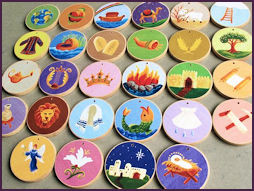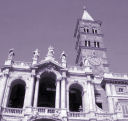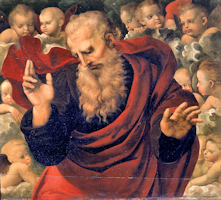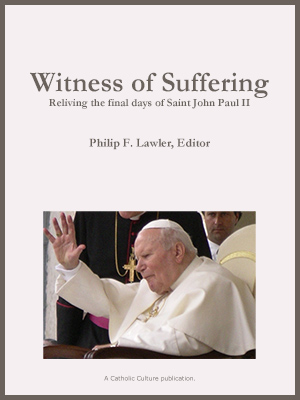» Enjoy our Liturgical Seasons series of e-books!
For Catholics, the new Liturgical Year commences with the First Sunday of Advent, opening the Advent season. In this new Liturgical Year, the Church not only wishes to indicate the beginning of a period, but the beginning of a renewed commitment to the faith by all those who follow Christ, the Lord. This time of prayer and path of penance that is so powerful, rich and intense, endeavors to give us a renewed impetus to truly welcome the message of the One who was incarnated for us. In fact, the entire Liturgy of the Advent season, will spur us to an awakening in our Christian life and will put us in a ‘vigilant’ disposition, to wait for Our Lord Jesus who is coming:
‘Awaken! Remember that God comes! Not yesterday, not tomorrow, but today, now! The one true God, "the God of Abraham, Isaac and Jacob," is not a God who is there in Heaven, unconcerned with us and our history, but he is the-God-who-comes.’1
The Season of Advent is therefore a season of vigilant waiting, that prepares us to welcome the mystery of the Word Incarnate, who will give the ‘Light’ to the womb of the Virgin Mary, but essentially this time prepares us not only to welcome this great event but to incarnate it in our lives. We could say that the true light enters the world through the immaculate womb of Mary but it does not stay there. On the contrary, this light flows out into our dark, obscure, sinful lives to illuminate them, so that we can become the light that illuminates the world. For this reason, let us live this time of waiting not only to celebrate a historical memory but to repeat this memory in our lives and in the service of others. To wait for the Lord who comes, means to wait and to watch so that the Word of Love enters inside us and focuses us every day of our lives.
As Saint John Henry Newman reminded us in a homily for the Advent Season: “Advent is a time of waiting, it is a time of joy because the coming of Christ is not only a gift of grace and salvation but it is also a time of commitment because it motivates us to live the present as a time of responsibility and vigilance. This ‘vigilance’ means the necessity, the urgency of an industrious, living ‘wait.’ To make all this happen, then we need to wake up, as we are warned by the apostle to the Gentiles, in today's reading to the Romans: ‘Besides this you know what hour it is, how it is full time now for you to wake from sleep. For salvation is nearer to us now than when we first believed' ” (Rm 13:11).
We must start our journey to ascend to the mountain of the Lord, to be illuminated by His Words of peace and to allow Him to indicate the path to tread (cf. Is 2:1-5). Moreover, we must change our conduct abandoning the works of darkness and put on the ‘armor of light’ and so seek only to do God’s work and to abandon the deeds of the flesh (cf. Rm 13:12-14). Jesus, through the story in the parable, outlines the Christian life style that must not be distracted and indifferent but must be vigilant and recognize even the smallest sign of the Lord’s coming because we don’t know the hour in which He will arrive (cf. Mt 24:39-44).
1 Pope Benedict XVI, Celebration of First Vespers of Advent, Vatican Basilica, December 2006
—Excerpted from Dicastery for the Clergy
![]()
Station Church Information >>>
The First Sunday of Advent marks the new Liturgical Year, and the Church shifts into a new Lectionary Cycle for Sundays, with 2022-23 returning to Year A, the Gospel of St. Matthew. In the Sunday Gospel (Matthew 24:37-44) Jesus invites us to recognize the signs of the last days. This is a reminder that Advent is not just looking back at the first coming of Christ at Christmas, but our personal preparation for His Second Coming: "Therefore, stay awake! For you do not know on which day your Lord will come....you also must be prepared, for an hour you do not expect, the Son of Man will come."
The traditional Collect (Opening Prayer) of the last Sunday of the Church year began "Stir up the wills of Thy faithful people, we beseech Thee, O Lord..." With this request to God to "stir up" our wills, this day was traditionally called Stir-Up Sunday. Because the Ordinary Form celebrates the Solemnity of Christ the King on the last Sunday of the year, "Stir-Up Sunday" can now be the First Sunday of Advent. The traditional Collect of the First Sunday is asking God to stir up His might: "Stir up Thy might, we beg Thee, and come." Many families create a traditional plum pudding or fruit cake or some other recipe that all the family and guests can "stir-up." This activity of stirring-up the ingredients symbolizes our hearts that must be stirred in preparation for Christ's birth.
What You Need to Know About Advent
Mass Readings for the First Sunday of Advent, Year A:
This prophecy of Isaiah, spoken 700 years before the coming of Christ, has been fulfilled. “The Word was made flesh and dwelt among us.” And we today, thousands of miles from Jerusalem, and almost two thousand years after his coming among us, are preparing ourselves for the annual commemoration of that greatest event of history.
The Second Reading is taken from the Letter of St. Paul to the Romans 13:11-14. In the verses chosen for today’s second reading, St. Paul urges Roman Christians to keep the purpose of their conversion, of their acceptance of the gospel, of true salvation, always before their eyes. They had accepted Christ in order to merit enteral salvation; for this reason, they must “Cast off the works of darkness,” in which they indulged before their conversion.
The Gospel is taken from Matthew 24:37-44. St. Matthew gives us a discourse which our Lord held with his disciples concerning the destruction of the temple of Jerusalem and the Parousia, or the second coming of Christ as judge of the world. In the verses we read today Christ is speaking of his second coming, and emphasizes its unexpectedness and suddenness.
In today’s lesson it is Christ himself who is asking each one of us so to live our lives that no matter when we are called to judgement we shall not be found wanting. This does not mean that we must always be praying. Nor does it mean that we must take no interest in the affairs of this life. Of the two men working in the field and the two women grinding corn, one of each was found unworthy, not because of the work he or she was doing, but because that work had for them wrongly excluded God and his purpose in life. The two found worthy had room for God and their own eternal welfare in their hearts—their work was part of their loyal service to God and was a means towards their salvation.
Christmas comes but once a year but its meaning, its lesson, must remain in our hearts and minds all the year round. God wants us in heaven forever. He sent his Son on earth to bring us there. Aided by God’s grace we resolve today so to live our lives that when death claims us we shall meet Christ, not as condemning judge, but as a loving brother.
The Jesse Tree or Tree of Jesse Overview
Printable Jesse Tree guide: The Jesse Tree: Advent 2022
A Jesse Tree Prayer Service
Jesse Tree, Day 1 ~ Creation Jesse Tree Overview Jesse was the father of King David and God promised David that his Kingdom would last forever. Two centuries after the death of King David, God spoke through the prophet Isaiah and said: And there shall come forth a rod out of the stem of Jesse, and a branch shall grow out of his roots: and the spirit of the Lord shall rest upon him: the spirit of wisdom and understanding, the spirit of counsel and fortitude, the spirit of knowledge, and of the fear of the Lord. (Isaiah 11:1-2) Each Jesse Tree ornament usually consists of a handmade symbol or drawing that represents one of the major stories of the Old Testament along with a brief verse of Scripture from that story.![]()
The First Reading is taken from Isaiah 2:1-5. Today’s lesson from Isaiah contains one of the encouraging speeches which God’s great prophet addressed to his fellow-Jews, to help them persevere in their faith in God. Days of distress and tribulation lay ahead. Jerusalem, their beloved and holy city, the site of the temple where the true God manifested his power and his mercy among them, was to be razed one day to the ground, because of their sins. But when the great day came and God fulfilled his promises to them, Jerusalem would once more be the glory and the pride, not only of the Jews, but of all nations.
—Excerpted from The Sunday Readings by Fr. Kevin O'Sullivan, O.F.M.![]()
![]()

The Jesse Tree dates back to Europe during the Middle Ages. Ancient cathedrals have Jesse Tree designs in their stained glass windows. The "tree" is usually a branch or sapling and is decorated with various symbols that remind us of the purpose and promises of God from Creation to the Birth of Jesus Christ.
![]()
Advent Reflection: Memory Awakens Hope
In one of his Christmas stories Charles Dickens tells of a man who lost his emotional memory; that is, he lost the whole chain of feelings and thoughts he had acquired in the encounter with human suffering. This extinction of the memory of love is presented to him as liberation from the burden of the past, but it becomes clear immediately that the whole person has been changed: now, when he meets with suffering, no memories of kindness are stirred within him. Since his memory has dried up. the source of kindness within him has also disappeared. He has become cold and spreads coldness around him.
Goethe deals with the same idea as Dickens in his account of the first celebration of the feast of St. Roch in Bingen after the long interruption caused by the Napoleonic wars. He observes the people as they press, tightly packed, through the church past the image of the saint, and he watches their faces: the faces of the children and the adults are shining, mirroring the joy of the festal day. But with the young people, Goethe reports, it was otherwise. They went past unmoved, indifferent, bored. And he gives an illuminating explanation: they were born in evil times, had nothing good to remember and consequently had nothing to hope for. In other words, it is only the person who has memories who can hope. The person who has never experienced goodness and kindness simply does not know what such things are.
Recently a counselor who spends much of his time talking with people on the verge of despair was speaking in similar terms about his own work: if his client succeeds in recalling a memory of some good experience, he may once again be able to believe in goodness and thus relearn hope; then there is a way out of despair. Memory and hope are inseparable. To poison the past does not give hope: it destroys emotional foundations.
Sometimes Charles Dickens' story strikes me as a vision of contemporary experience. This man who let himself be robbed of the heart's memory by the delusion of a false liberation — do we not find him with us today, in a generation whose past has been poisoned by a particular program of liberation that has stifled hope? When we read of the pessimism with which our young people look toward the future, we ask ourselves, Why? Is it that, in the midst of material affluence, they have no memory of human goodness that would allow them to hope? By outlawing the emotions, by satirizing joy, have we not trampled on the root of hope?
These reflections bring us straight to the significance of the Christian season of Advent. For Advent is concerned with that very connection between memory and hope which is so necessary to man. Advent's intention to awaken the most profound and basic emotional memory within us, namely, the memory of the God who became a child. This is a healing memory; it brings hope. The purpose of the Church's year is continually to rehearse her great history of memories, to awaken the heart's memory so that it can discern the star of hope. All the feasts in the Church's calendar are events of remembrance and hence events of hope. These events, of such great significance for mankind, which are preserved and opened up by faith's calendar, are intended to become personal memories of our own life history through the celebration of holy seasons by means of liturgy and custom. Our personal memories are nourished by mankind's great memories; in turn, it is only by translating them into personal terms that these great memories are kept alive. Man's ability to believe always depends in part on faith having become dear on the path of life, on the humanity of God having manifested itself through the humanity of men. No doubt each of us could tell his own story here as to what the various memories of Christmas, Easter or other festivals mean in his life.
It is the beautiful task of Advent to awaken in all of us memories of goodness and thus to open doors of hope.
—Joseph Cardinal Ratzinger, Seek That Which is Above
Roman Station Churches of Advent and Christmas
Roman Stational churches or station churches are the churches that are appointed for special morning and evening services during Lent, Easter and other important days during the Liturgical Year. This ancient Roman tradition started in order to strengthen the sense of community within the Church in Rome, as this system meant that the Holy Father would visit each part of the city and celebrate Mass with the congregation.
"So vividly was the station saint before the minds of the assembled people that he seemed present in their very midst, spoke and worshiped with them. Therefore the missal still reads, "Statio ad sanctum Paulum," i.e., the service is not merely in the church of St. Paul, but rather in his very presence. In the stational liturgy, then, St. Paul was considered as actually present and acting in his capacity as head and pattern for the worshipers. Yes, even more, the assembled congregation entered into a mystical union with the saint by sharing in his glory and by seeing in him beforehand the Lord's advent in the Mass" (Pius Parsch, The Church's Year of Grace, Vol. 2, p. 71).
The Lenten stations are the most prominent since they encompass every day during the Lenten season. However, there are other times of the year with traditional station churches. The Advent and Christmas seasons include the four Advent Sundays, Christmas Eve, Christmas Day with three different churches for the three Masses of the Day, and the three feasts after Christmas and the Octave Day of Christmas (January 1) and Epiphany, and the Advent Ember Days.
For more information, see:
- The Stational Church by Jennifer Gregory Miller
- Roman Pilgrimage: The Station Churches, a review of George Weigel's book by Jennifer Gregory Miller
- Following the Roman Stations by Jennifer Gregory Miller
- A Peek Into Our Daily Roman Station Walk by Jennifer Gregory Miller
- At Home: Lent and Easter by Florence Berger
- Pontifical Academy of the Martyrs: Lenten Stations (Text in Italian)—the Academy has been encouraging the display and veneration of relics at the stational churches.
- The Pontifical North American College: The Roman Station Liturgy—includes commentary for each Stational day
- Roman Station Churches with Fr. Bill

First Sunday of Advent
Station with Santa Maria Maggiore (St. Mary Major):
We enter the house of God. Mary, God's Mother, is preparing the crib in which to lay her Son; she comes to meet us. What a beautiful model of preparation! The stational church is St. Mary Major at the Crib and its stational Saint meets us! Already on this first day of preparation for Christmas, we see the Mother of God at the crib! Mary now leads us to the altar, where she speaks to us and leads us in prayer. We ask our blessed Mother Mary, the fruitful earth fecundated by the goodness of the Lord, the patroness on the first day of the New Year as well as on this first day of Advent, to obtain for us the grace to prepare with becoming honor for the approaching solemnity of our redemption. Mary is the highest expression, the perfect model of true Advent spirit. On this account do we begin our Advent observance in the great Marian Church Ad praesepe, at the crib. To the Christians of Rome this church was Bethlehem. In 342 A.D. it was built to commemorate the Council of Ephesus, and dedicated to the Mother of God. Our best model for the Advent-Christmas season is, surely, Mary our Mother (adapted from Pius Parsch, OSB, The Church's Year of Grace and Martin Hellriegel, Vine and Branches).
For more on Santa Maria Maggiore, see:
For further information on the Station Churches, see The Stational Church.






